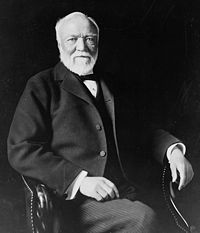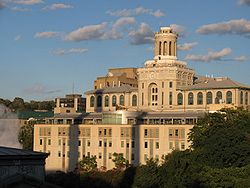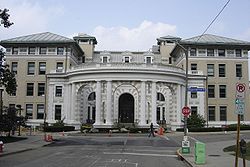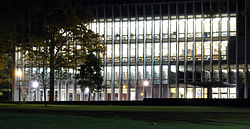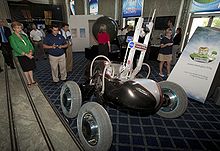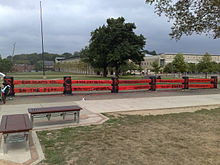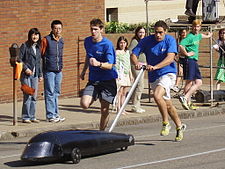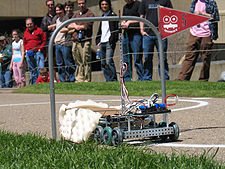- Carnegie Mellon University
-
Carnegie Mellon University 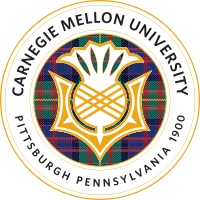
Motto "My heart is in the work" (Andrew Carnegie) Established 1900 by Andrew Carnegie Type Private university Endowment US $815.1 million (February 24, 2011)[1] President Jared Cohon Provost Mark Kamlet Academic staff 1,368 Undergraduates 5,705 Postgraduates 5,265 Location Pittsburgh, Pennsylvania, USA Campus Urban, 144 acres (58 ha) Colors Cardinal, Gray, and Tartan Plaid[2] Athletics NCAA Division III UAA
17 varsity teams[3]Nickname Tartans Mascot Scotty the Scottie Dog[4] Website cmu.edu 
Coordinates: 40°26′36″N 79°56′37″W / 40.443322°N 79.943583°W Carnegie Mellon University (also known as Carnegie Mellon or simply CMU) is a private research university in Pittsburgh, Pennsylvania, United States.
The university began as the Carnegie Technical Schools, founded by Andrew Carnegie in 1900. In 1912, the school became Carnegie Institute of Technology and began granting four-year degrees. In 1967, the Carnegie Institute of Technology merged with the Mellon Institute of Industrial Research to form Carnegie Mellon University. The university's 140-acre (0.57 km2) main campus is 3 miles (4.8 km) from Downtown Pittsburgh and abuts the Carnegie Museums of Pittsburgh, Schenley Park, and the campus of the University of Pittsburgh in the city's Oakland and Squirrel Hill neighborhoods, partially extending into Shadyside.
Carnegie Mellon has seven colleges and independent schools: the Carnegie Institute of Technology (engineering), College of Fine Arts, Dietrich College of Humanities and Social Sciences, Mellon College of Science, Tepper School of Business, School of Computer Science, and H. John Heinz III College.
Carnegie Mellon students come from all 50 U.S. states and 93 countries. It consistently ranks among the top 25 universities in the United States and was named one of the "New Ivies" by Newsweek in 2006.[5] The campus neighbors the University of Pittsburgh, and the two schools have collaborated on such projects as the Pittsburgh Commuting Center, the Immune Modeling Center and the Center for the Neural Basis of Cognition.[6] Some professors hold joint professorships between the two schools, and CMU students may take classes at Pitt (with approval of the university), and vice-versa. Students from both schools can register in dual-degree programs, and CMU students and faculty also have access to the University of Pittsburgh library system.
Contents
History
Post-Civil War industrialists accumulated unprecedented wealth and were eager to found institutions in their names as part of their philanthropy campaigns. Washington Duke at Duke University, Ezra Cornell at Cornell University, Johns Hopkins at Johns Hopkins University, Leland Stanford at Stanford University, and Cornelius Vanderbilt at Vanderbilt University are several notable examples of Andrew Carnegie's gospel of wealth mentality and Carnegie Mellon University is one such result.
Carnegie Mellon predecessor institution, Carnegie Technical Schools, was founded in 1900 in Pittsburgh by the Scottish American industrialist and philanthropist Andrew Carnegie, who wrote the time-honored words "My heart is in the work", when he donated the funds to create the institution. Carnegie's vision was to open a vocational training school for the sons and daughters of working-class Pittsburghers (Many of whom worked in his mills). The campus began to take shape in the Beaux-Arts architecture style of Henry Hornbostel, winner of the 1904 competition to design the original institution and later the founder of what is now the Carnegie Mellon School of Architecture. The name was changed to the Carnegie Institute of Technology in 1912, and the school began offering four-year degrees. In 1965, it merged with Andrew Mellon's Mellon Institute of Industrial Research to become Carnegie Mellon University. In addition, Carnegie founded Carnegie Mellon's coordinate women's college, Margaret Morrison Carnegie College in 1903 (which closed in 1973).[7]
There was little change to the campus between the first and second World War. A 1938 master plan by Githens and Keally suggested acquisition of new land along Forbes Avenue, but the plan was not fully implemented. The period starting with the construction of the Graduate School of Industrial Administration building (1952) and ending with Wean Hall (1971) saw the institutional change from Carnegie Institute of Technology to Carnegie Mellon University. New facilities were needed to respond to the University's growing national reputation in artificial intelligence, business, robotics and the arts. In addition, an expanding student population resulted in a need for improved facilities for student life, athletics and libraries. The campus finally expanded to Forbes Avenue from its original land along Schenley Park. A ravine long known as "the cut" was gradually filled in to campus level, joining "the Mall" as a major campus open space.
The buildings of this era reflect current attitudes toward architectural style. The International Style, with its rejection of historical tradition and its emphases on functionalism and expression of structure, had been in vogue in urban settings since the 1930s. It came late to the Carnegie campus because of the hiatus in building activity and a general reluctance among all institutions of higher education to abandon historical styles. By the 1960s, it was seen as a way to accomplish the needed expansion and at the same time give the campus a new image. Each building was a unique architectural statement that may have acknowledged the existing campus in its placement, but not in its form or materials.
During the 1970s and 1980s, the tenure of legendary University President Richard M. Cyert (1972–1990) witnessed a period of unparalleled growth and development. The research budget soared from roughly US$12 million annually in the early 1970s to more than US$110 million in the late 1980s. The work of researchers in new fields like robotics and software engineering helped the university build on its reputation for innovation and practical problem solving. President Cyert stressed strategic planning and comparative advantage, pursuing opportunities in areas where Carnegie Mellon could outdistance its competitors. One example of this approach was the introduction of the university's "Andrew" computing network in the mid-1980s. This pioneering project, which linked all computers and workstations on campus, set the standard for educational computing and established Carnegie Mellon as a leader in the use of technology in education and research. On April 24, 1984, cmu.edu, Carnegie Mellon's internet domain, became amongst the first six .edu URLs.
Carnegie Mellon today
In the 1990s and into the 2000s, Carnegie Mellon solidified its status among elite American universities, consistently ranking in the top 25 in US News and World Report rankings. Carnegie Mellon is distinct in its interdisciplinary approach to research and education. Through the establishment of programs and centers that are outside the limitations of departments or colleges, the university has established leadership in fields such as computational finance, information systems management, arts management, product design, behavioral economics, human-computer interaction, entertainment technology, and decision science. Within the past two decades, the university has built a new University Center, theater and drama building (Purnell Center), business school building (Posner Hall), a new student union, and several dormitories. Baker Hall was renovated in the early 2000s, and new chemistry labs were established in Doherty Hall soon after. Several computer science buildings, such as Newell Simon Hall, also were established, renovated, or renamed in the early 2000s. The university has most recently completed building the Gates Hillman Complex and continues renovating historic academic and residence halls.
The Gates Hillman Complex, opened for occupancy on August 11, 2009, sits on a 5.6-acre (23,000 m2) site on the university's West Campus, surrounded by Cyert Hall, the Purnell Center for the Arts, Doherty Hall, Newell-Simon Hall, Smith Hall, Hamburg Hall and the Collaborative Innovation Center. It contains 318 offices as well as labs, computer clusters, lecture halls, classrooms and a 250-seat auditorium. The Gates Hillman Complex was made possible by a $20 million lead gift from the Bill & Melinda Gates Foundation and an additional $10 million grant from The Henry L. Hillman Foundation. The Gates Hillman Complex and the Purnell Center for the Arts are connected by the Randy Pausch Memorial Footbridge.[9]
On April 15, 1997, Jared L. Cohon, former dean of Yale University's School of Forestry and Environmental Studies, was elected president by Carnegie Mellon's Board of Trustees. During Cohon's presidency, Carnegie Mellon has continued its trajectory of innovation and growth. He leads a strategic plan that aims to leverage the University's strengths to benefit society in the areas of biotechnology and life sciences, information and security technology, environmental science and practices, the fine arts and humanities, and business and public policy.
On July 1, 2003 Carnegie Mellon launched Insp!re Innovation, a $1 billion comprehensive fund raising campaign. Half of the campaign goal is intended for the endowment to provide long-lasting support for faculty, students and breakthrough innovations. As of November 2011, the campaign had brought in $957.8 million, with $512.4 million going toward Carnegie Mellon’s endowment. It also enabled the university to establish 24 endowed professorships, 73 endowed fellowships and 190 endowed scholarships.[10] On September 7th, 2011, William S. Dietrich II, the former chairman of Dietrich Industries, Inc., a subsidiary of Worthington Industries, Inc., pledged a gift of $265 million, effective on October 6th, 2011, upon his death. In response to this gift, Carnegie Mellon renamed the College of Humanities of Social Sciences as the Marianna Brown Dietrich College of Humanities and Social Sciences after William Dietrich's mother.[11]
Peer institutions of Carnegie Mellon's institutional research and analysis program include Caltech, Cornell, Duke, Emory, Georgia Tech, MIT, Northwestern, Princeton, Rice, RPI, Stanford, Penn and Washington University.[12]
Campus
Carnegie Mellon's 140-acre (0.57 km2) main campus is three miles (5 km) from downtown Pittsburgh, between Schenley Park and the Squirrel Hill, Shadyside, and Oakland neighborhoods. Carnegie Mellon is bordered to the west by the campus of the University of Pittsburgh. Carnegie Mellon owns 81 buildings in the Oakland and Squirrel Hill neighborhoods of Pittsburgh.
For decades the center of student life on campus was "Skibo Hall", the University's student union. Built in the 1950s, Skibo Hall's design was typical of Mid-Century Modern architecture, but was poorly equipped to deal with advances in computer and internet connectivity. The original Skibo was razed in the summer of 1994 and replaced by a new student union that is fully wi-fi enabled. Known as University Center, the building was dedicated in 1996.
A large grassy area known as "the Cut" forms the backbone of the campus, with a separate grassy area known as "the Mall" running perpendicular. The Cut was formed by filling in a ravine (hence the name) with soil from a nearby hill that was leveled to build the College of Fine Arts building.
The northwestern part of the campus (home to Hamburg Hall, Newell-Simon Hall, Smith Hall, and Gates Hillman Complex) was acquired from the United States Bureau of Mines in the 1980s.
In 2006, Carnegie Mellon Trustee Jill Gansman Kraus donated the 80-foot (24 m)-tall sculpture Walking to the Sky, which was placed the lawn facing Forbes Ave between the University Center and Warner Hall. The sculpture was controversial for its placement, the general lack of input that the campus community had, and its aesthetic appeal.[13]
A panoramic view of Carnegie Mellon University's Pittsburgh campus from the College of Fine Arts Lawn.
From left to right: College of Fine Arts, Hunt Library, Baker and Porter Hall, Hamerschlag Hall, University of Pittsburgh's Cathedral of Learning (in the background), Wean Hall and Doherty Hall, Purnell Center, and the University Center. Also visible are "The Fence," and the "Walking to the Sky" sculpture.Beyond Pittsburgh
In addition to its Pittsburgh campus, Carnegie Mellon has a branch campus in the Middle East, Carnegie Mellon University in Qatar, which offers a full undergraduate curriculum with degree programs in computer science, business administration and information systems. It also has graduate-level extension campuses in Mountain View, California in the heart of Silicon Valley (offering masters programs in Software Engineering and Software Management). The Tepper School of Business maintains a satellite center in downtown Manhattan and the Heinz College maintains one in Adelaide, Australia and one in Washington, DC. Carnegie Mellon also maintains the Carnegie Mellon Los Angeles Center in North Hollywood, California where students in the Master of Entertainment Industry Management program are required to relocate to Los Angeles in their second year and attend classes at this facility. Carnegie Mellon's Information Networking Institute offers graduate programs in Athens, Greece and Kobe, Japan, in collaboration with Athens Information Technology and the Hyogo Institute of Information Education Foundation, respectively. In the fall of 2007, the cities of Aveiro and Lisbon, Portugal were added to the Information Networking Institute's remote locations. The Institute for Software Research International (ISRI) offers graduate programs in Coimbra, Portugal.The Entertainment Technology Center offers graduate programs in Portugal, Japan, and Singapore. The Human-Computer Interaction Institute offers a masters degree in conjunction with the University of Madeira, in Portugal.
In media, entertainment, and culture
The Carnegie Mellon University campus in Pittsburgh has served as the locale for many motion pictures. Alumnus George A. Romero filmed Creepshow (1982) in and around Margaret Morrison Hall. Much of the on-campus scenes in the 2000 film Wonder Boys, starring Michael Douglas and Tobey Maguire, were filmed in Carnegie Mellon's campus. Other movies filmed at Carnegie Mellon include The Mothman Prophecies, Dogma, Lorenzo's Oil, The Dark Knight Rises, and Flashdance. The university is also featured prominently in the film Smart People, starring Sarah Jessica Parker and Dennis Quaid, and in the anime Summer Wars. It was also referenced on an episode of The Simpsons and in the movie Mean Girls 2. Carnegie Mellon was identified as the university "Rat" went to in the science fiction movie The Core, as well as the university that one of the astronauts attended in the film Deep Impact.[14]
The play Pippin was originally conceived by Stephen Schwartz as a student musical performed by the Scotch'n'Soda student theatre troupe.[15]
While enrolled at Carnegie Mellon, acting students Michael McKean and David Lander (class of 1969) created the characters "Lenny & Squiggy". The pair continued performing the characters in live comedy routines before joining the cast of the TV series Laverne and Shirley.
In 2008, Carnegie Mellon professor Randy Pausch's "Last Lecture" became a pop culture phenomenon. Based on a lecture he gave in September 2007 - shortly after he learned his cancer had metastasized - his book quickly rose to the top of bestseller lists around the country. Named in Time Magazine's "Time 100" list of influential people, he died in July 2008 from pancreatic cancer.[16]
Carnegie Mellon also established and administers the Robot Hall of Fame in partnership with the Carnegie Science Center.
Schools and divisions
- The Carnegie Institute of Technology includes seven engineering departments: Biomedical Engineering, Chemical Engineering, Civil and Environmental Engineering, Electrical and Computer Engineering, Engineering and Public Policy, Mechanical Engineering, and Materials Science and Engineering, and two institutes, the Information Networking Institute and the Institute for Complex Engineered Systems.
- The College of Fine Arts is the second oldest college of fine arts in the United States (behind the Maryland Institute College of Art), and today it is a federation of schools with professional training programs in the visual and performing arts: Architecture, Art, Design (ranked #1 MFA program in Multimedia and Visual Communication),[17] Drama and Music. The college shares research projects, interdisciplinary centers and educational programs with other units across the university. The college initiated several interdisciplinary program which facilitate graduate student research and enrich their knowledge.
- The H. John Heinz III College offers masters degrees in Public Policy and Management, Health Care Policy and Management, Biotechnology and Management, Medical Management, Public Management, Arts Management, Entertainment Industry Management, Information Systems Management, Information Technology, and Information Security Policy and Management. It consists of the School of Information Systems & Management and the School of Public Policy & Management. It also offers various Ph.D. and executive education programs.
- The Dietrich College of Humanities and Social Sciences is the university's liberal and professional studies college and emphasizes the study of the human condition through rigorous analysis and technology. Departments include Economics, English, History, Modern Languages, Philosophy, Psychology, Social and Decision Sciences and Statistics. The college also offers undergraduate degree programs in Information systems and International Relations and Politics.
- The Mellon College of Science includes four departments: Biological Sciences, Chemistry, Mathematical Sciences and Physics. In addition, the college is expanding efforts in green chemistry, bioinformatics, computational biology, nanotechnology, computational finance, sensor research and biological physics.
- The School of Computer Science: Carnegie Mellon University helped define, and continually redefines, the field of computer science. The School of Computer Science is recognized internationally as one of the top schools for computer science.[18]
- The Tepper School of Business offers undergraduate programs in Business Administration and Economics. Undergraduate Tepper students can choose from an array of tracks including: Finance, Information Technology, Entrepreneurship, Management, Consulting, and Marketing. In addition to choosing a track, undergraduate Tepper students must also choose a minor from one of the other colleges on campus and take a variety of supplemental breadth courses outside of the business program. The Tepper School offers masters degrees in Business Administration (MBA) and joint degrees in Computational Finance (MSCF) with the Dietrich College of Humanities and Social Sciences, the Mellon College of Science, and the School of Computer Science. In addition, joint degrees are offered with Civil and Environmental Engineering and the Heinz College. The Tepper School also offers doctoral degrees in several areas and presents a number of executive education programs.
In addition to the research and academic institutions, the University hosts the Pennsylvania Governor's School for the Sciences, a state-funded summer program that aims to foster interest in science amongst gifted high school students, and the Carnegie Mellon Institute for Talented Elementary and Secondary Students program (C-MITES). The Cyert Center for Early Education is a child care center for Carnegie Mellon faculty and staff, as well as an observational setting for students in child development courses.
Carnegie Mellon University Libraries include Hunt Library, the Engineering and Science Library, the Mellon Institute Library, the Posner Center, and the Qatar Library. Additionally the Libraries manage the Software Engineering Institute Library, and the Universal Digital Library. The library system includes a number of special collections such as the Andrew Carnegie Collection, Herbert Simon Collection, Allen Newell Collection, the H. John Heinz III Collection, and the Posner Memorial Collection among many others. Carnegie Mellon students and faculty also have access to the Carnegie Library of Pittsburgh and the University of Pittsburgh libraries through the Oakland Library Consortium. The Hunt Institute for Botanical Documentation (HIBD), a research division of Carnegie Mellon University, and its library collections are located on the top floor of Hunt Library, but are not part of the University Library System.[19]
Carnegie Mellon also manages the Naval Reserve Officer Training Corps in Pittsburgh on which students throughout Pittsburgh's universities rely. Carnegie Mellon relies on the University of Pittsburgh to provide opportunities in Army Reserve Officers' Training Corps and Air Force Reserve Officer Training Corps to its students.
Undergraduate profile
In 2011, the Pittsburgh campus received a record 27,913 unique applicants and admitted 5,948 (21%). 1,443 students enrolled in the class of 2015 (24%).[20]
In 2011, the most selective undergraduate college was the School of Computer Science, which admitted only 13.6% of total applicants. The largest college, in terms of enrollment, is the Carnegie Institute of Technology with 455 students in the class of 2015, followed by the Dietrich College of Humanities & Social Sciences with 241, and the College of Fine Arts with 235. The smallest college in terms of total undergraduate enrollment is the Tepper School of Business (with 90). Carnegie Mellon enrolls students from all 50 states and the District of Columbia, and 15.6% of the students are citizens of countries other than the United States, representing more than 40 countries. About 96.3% of first-year students enrolled in 2009 returned for their second year, and 72.7% of students in the class of 2010 graduated within four years. Undergraduate tuition is $43,160 and room and board is $11,110.[21]
Research
For the 2006 fiscal year, the University spent $315 million on research. The primary recipients of this funding were the School of Computer Science ($100.3 million), the Software Engineering Institute ($71.7 million), the Carnegie Institute of Technology ($48.5 million), and the Mellon College of Science ($47.7 million). The research money comes largely from federal sources, with federal investment of $277.6 million. The federal agencies that invest the most money are the National Science Foundation and the Department of Defense, which contribute 26% and 23.4% of the total university research budget respectively.[21]
The Pittsburgh Supercomputing Center (PSC) is a joint effort between Carnegie Mellon University, University of Pittsburgh, and Westinghouse Electric Company. PSC was founded in 1986 by its two scientific directors, Dr. Ralph Roskies of the University of Pittsburgh and Dr. Michael Levine of Carnegie Mellon University. PSC is a leading partner in the TeraGrid, the National Science Foundation’s cyberinfrastructure program.[22]
The Robotics Institute (RI) is a division of the School of Computer Science and considered to be one of the leading centers of robotics research in the world. The Field Robotics Center (FRC) has developed a number of significant robots, including Sandstorm and H1ghlander, which finished second and third in the DARPA Grand Challenge, and Boss, which won the DARPA Urban Challenge. The RI is primarily sited at Carnegie Mellon's main campus in Newell-Simon hall.[23]
The Software Engineering Institute (SEI) is a federally funded research and development center sponsored by the U.S. Department of Defense and operated by Carnegie Mellon University, with offices in Pittsburgh, Pennsylvania, USA; Arlington, Virginia, and Frankfurt, Germany. The SEI publishes books on software engineering for industry, government and military applications and practices. The organization is known for its Capability Maturity Model (CMM) and Capability Maturity Model Integration (CMMI), which identify essential elements of effective system and software engineering processes and can be used to rate the level of an organization's capability for producing quality systems. The SEI is also the home of CERT/CC, the federally-funded computer security organization. The CERT Program's primary goals are to ensure that appropriate technology and systems management practices are used to resist attacks on networked systems and to limit damage and ensure continuity of critical services subsequent to attacks, accidents, or failures.[24]
The Human-Computer Interaction Institute (HCII) is a division of the School of Computer Science and is considered one of the leading centers of human-computer interaction research, integrating computer science, design, social science, and learning science.[25] Such interdisciplinary collaboration is the hallmark of research done throughout the university.
The Language Technologies Institute (LTI) is another unit of the School of Computer Science and is famous for being one of the leading research centers in the area of language technologies. Primary research focus of the institute is on machine translation, speech recognition, speech synthesis, information retrieval, parsing and information extraction.[26] Until 1996, the institute existed as the Center for Machine Translation that was established in 1986. From 1996 onwards, it started awarding graduate degrees and the name was changed to Language Technologies Institute.
Carnegie Mellon is also home to the Carnegie School of management and economics. This intellectual school grew out of the Tepper School of Business in the 1950s and 1960s and focused on the intersection of behavioralism and management. Several management theories, most notably bounded rationality and the behavioral theory of the firm, were established by Carnegie School management scientists and economists.
Carnegie Mellon has made a concerted effort to attract corporate research labs and offices to the Pittsburgh campus. Apple Inc., Intel, Google, Microsoft, Disney, IBM, General Motors, Bombardier Inc., and the Rand Corporation have established a presence on or near campus. In collaboration with Intel, Carnegie Mellon has pioneered research into claytronics.[27]
Alumni and faculty
There are more than 86,500 Carnegie Mellon alumni worldwide. Famous alumni include former General Motors CEO and Secretary of Defense, Charles Erwin Wilson; billionaire hedge fund investor David Tepper; James Gosling, creator of the Java programming language; Andy Bechtolsheim, co-founder of Sun Microsystems; pop artists Andy Warhol and Burton Morris; Mountaineer and Author Aron Ralston; and astronaut Judith Resnik, who perished in the Space Shuttle Challenger disaster. A memorial to Judy Resnik can be found near Porter Hall, sponsored by the engineering fraternity.
Overall, Carnegie Mellon is affiliated with eighteen Nobel laureates,[28] eleven Turing Award winners, ninety seven Emmy Award recipients (including ten time recipient Steven Bochco), six Academy Award recipients, and twenty two Tony Award recipients (including Andrew Omondi). John Forbes Nash, a 1948 graduate and winner of the 1994 Nobel Prize in Economics, was the subject of the book and subsequent film A Beautiful Mind. Alan Perlis, a 1943 graduate was a pioneer in programming languages and recipient of the first ever Turing award.
Carnegie Mellon alumni have had success in Hollywood, Broadway, television, and the music industry. They include Best Actress Academy award winner Holly Hunter (1980), ten time Emmy Award-winning TV producer/writer Steven Bochco, actor Patrick Wilson, actor George Peppard (1951), actor Frank Gorshin (did not graduate), actor René Auberjonois (1962), actor Jack Klugman (1948), actress Carol Channing (1943), actor Robert Cummings (1930), actress Mariette Hartley (1965), actor Ethan Hawke (did not graduate), actor Zachary Quinto (1999), actor James Cromwell (1964), Get Smart actress Barbara Feldon (1955), actor Ted Danson (1972), actor Robert Brooks (1969), actor Michael McKean (1969), actor David Lander (1969), actress and stunt woman Patricia Tallman, legendary horror director George A. Romero, actor Van Hansis, actor Rhys Coiro, actor Blair Underwood, broadway actress/singer Megan Hilty (2004), actress Cote de Pablo (2000), actress Jean Carson (1945), actress Cherry Jones (1978), actress Nancy Marchand (1949), actress Sada Thompson (1949), actress Jill Eikenberry (did not graduate), actor Gaius Charles (2005), actor G. Wood (1945), actress Barbara Bosson (did not graduate), baritone opera singer Liam Bonner, actor Josh Gad (2003), actor Matthew Bomer (2001), and actor Gabriel Macht (1994).
Rankings and reputation
University Rankings Ranking # US News & World Report (National) 23 Times Higher Education (World) 21 QS World University Rankings 43 In 2011 Carnegie Mellon ranked 23rd among "national universities" in the US News and World Report and 21st by the Times Higher Education World University Rankings. Carnegie Mellon is ranked 1st for graduate studies in computer science, a position consistently held in the past except in 2009. It is also 6th for graduate studies in engineering, 7th for graduate studies in fine arts, 7th for graduate studies in electrical engineering, 10th for graduate studies in public affairs, 16th for graduate studies in business, 19th for graduate studies in economics, 9th for graduate studies in statistics, and 17th for graduate studies in psychology in the 2011 rankings released by US News and World Report.[29] The undergraduate business program is also ranked 2nd for information systems, production/operations, and quantitative analysis, 5th for supply chain management, 9th for finance, 16th for entrepreneurship, 24th for general management, and 7th as an undergraduate business program overall by the 2011 US News and World Report.[29] In 2010, the Wall Street Journal ranked Carnegie Mellon 1st in computer science, 4th in finance, 7th in economics, 10th overall, and 21st in engineering according to job recruiters.[30] The university is one of 62 elected members of the Association of American Universities and its academic reputation has led it to be included in Newsweek’s list of “New Ivies”.[31] BusinessWeek's rankings of college return on investment placed Carnegie Mellon at 17th in the country.[32] BusinessWeek's 2011 rankings of the best undergraduate business schools have also placed the Tepper School of Business's undergraduate business program at 3rd for starting salaries (competing with Wharton School of Business and the MIT Sloan School of Management) and 4th for academic quality.[33] In SmartMoney's rankings of the most valuable colleges, Carnegie Mellon ranked 4th amongst private universities and 23rd amongst all universities nation-wide.[34]
Carnegie Mellon's offerings in computer science, engineering, business, economics, public policy, information systems, psychology, statistics, creative writing, entertainment technology, decision science, and the arts are considered among the best in their fields.[35]
Student life
Carnegie Mellon's student life includes over 225 student organizations, art galleries, and various unique traditions. Student organizations provide social, service, media, academic, spiritual, recreational, sport, religious, political, cultural, and governance opportunities. Carnegie Mellon's campus houses several galleries such as The Frame, a student-devoted gallery, and the Regina Gouger Miller Gallery, an art gallery that specializes in contemporary professional artists. The Carnegie Mellon Philharmonic, Carnegie Mellon School of Drama and the student-run theatrical organization Scotch'n'Soda provides campus with a variety of world-class performance arts events. The university has a strong Scottish motif inspired by Andrew Carnegie's Scottish heritage, as well as Andrew Mellon's Scots-Irish ancestry. Examples include Scotty, the Scottish Terrier mascot, The Tartan student newspaper, Skibo Gymnasium, and The Thistle yearbook.
Traditions
- The Fence - In the early days of Carnegie Tech, there was a single bridge, which connected Margaret Morrison Women's College with the Carnegie Institute of Technology. The bridge was a meeting place for students. In 1916, the bridge was taken down and the university filled in the area. The administration built a wooden fence as a new meeting place. The students did not understand why anyone would want to meet at a fence. Administration was about to give up and tear it down but that night a fraternity, as a prank, painted the entire fence advertising a fraternity party. Ever since, painting the Fence has been a Carnegie Mellon tradition.[36] The Fence at Carnegie Mellon lies at the center of campus, in the area known as “the cut." Students “guard” the fence 24 hours a day, and, as long as two vigils are maintained, no other student may “take” the fence. The fence can then be painted by the group that has it, but only between midnight and 6 am. Only hand brushes may be used; the use of spray paint or paint rollers is considered vandalism and results in a fine. The previous paint cannot be stripped, and each new painting adds a new layer. The original wooden fence finally collapsed in the 1990s due to the weight from over 1' of surrounding paint, and was immediately replaced with an identical one manufactured from concrete. Today the fence is considered "the world's most painted object", by the Guinness Book of World Records.
- Spring Carnival - Usually held in April, Spring Carnival is the biggest event of the school year. In addition to classic carnival attractions, the Spring Carnival features the “Buggy Sweepstakes” and "Booth" (a competition between various organizations to build small, elaborate booths based on a theme chosen each year).
- Buggy Races - Buggy, officially called Sweepstakes, is a race around Schenley Park. It can be thought of as a relay race with five runners, using the buggy vehicle as the baton. Entrants submit a small, usually torpedo-shaped, vehicle that is pushed uphill and then allowed to roll downhill. The vehicles are unpowered, including the prohibition of such energy-storing devices as flywheels. They are, however, steered by a driver who is usually a petite female student lying prone, arms stretched forward to steer via a turning mechanism. Space is so tight inside the buggies that the drivers usually cannot change position beyond turning their heads.
- Mobot - "Mobot,' a portmanteau for "mobile robot," is an annual competition at Carnegie Mellon that made its debut in 1994. In this event, robots try (autonomously) to pass through gates, in order, and reach the finish line. There is a white line on the pavement connecting the gates, and the line is normally used to find the gates, though it is not mandated by the rules that the robots follow the line.
- Bagpipers - As one of the only Colleges offering a degree in bagpipe music (the other being UC Riverside),[37] Carnegie Mellon's Pipe Band features the sounds of Scottish bagpipes and performs at University events. Head of the Pipe Band is champion piper Andrew Carlisle, a highly decorated solo piper and long time member of six times World Pipe Band Champions Field Marshal Montgomery.
- The Kiltie Band- Carnegie Mellon's Kiltie Band, dressed in full Scottish regalia including kilts and knee socks, performs during every home football game.
- Autographing the Green Room - Seniors in the College of Fine Arts sign the Green Room's walls and ceilings before leaving the university. Supposedly, Oscar-winning actress Holly Hunter broke university tradition by signing the Green Room during her freshman year.
Housing
Carnegie Mellon offers conventional housing for its students through single-gender, coeducational, and special interest options. Students can choose from standard, prime, or suite-style rooms, efficiencies, one or two bedroom apartments, and houses. There are 20 residential buildings on campus and 5 off campus in the Oakland area of Pittsburgh.[38]
Most incoming freshmen are assigned to the dedicated freshman residence halls on campus, including: Morewood E-Tower, Residence on Fifth, and the Boss, Donner, Hamerschlag, McGill, Mudge, Scobell, and Stever houses. The upperclassmen who choose to live in university housing do so in the remaining residence halls: Morewood Gardens and West Wing in addition to the Doherty, Fairfax, Margaret Morrison, Neville, Shady Oak, Shirley, and Woodlawn Apartments and the Henderson, Resnik, Roselawn, Spirit, Tech, Webster, and Welch houses.[38]
Fraternities and sororities
Main article: Fraternities and sororities at Carnegie Mellon UniversityThe Greek tradition at Carnegie Mellon University began nearly 100 years ago with the founding of the first fraternity on campus, Theta Xi, in 1912. The Panhellenic sorority community was founded in 1945, by Chi Omega, Delta Delta Delta, Delta Gamma, Kappa Alpha Theta, and Kappa Kappa Gamma. The Chi Omega chapter at Carnegie Mellon has since become Alpha Chi Omega, although the similarity between the two women's fraternity names is incidental.
Currently, Carnegie Mellon University has ten active Fraternities: Alpha Epsilon Pi, Beta Theta Pi, Delta Tau Delta, Kappa Sigma, Sigma Alpha Epsilon, Sigma Nu, Sigma Phi Epsilon, Sigma Tau Gamma, Sigma Chi (colony) and Delta Upsilon (colony).
In addition to participating in campus traditions such as Buggy and Booth, the fraternities and sororities hold an annual fundraiser called Greek Sing, one of the largest Greek events of the year. Each year, the organizations vote on a cause to support and raise money through ticket sales, ad sales, corporate sponsorships and donations. Each organization performs a 13-minute long original show or a rendition of a popular show. In Spring 2010, Greek Sing raised over $42,000 for St. Jude Children's Research Hospital.
Athletics
The Carnegie Mellon Tartans were a founding member of the University Athletic Association of the NCAA Division III. Prior to World War II Carnegie Mellon (as Carnegie Tech) played with NCAA Division I teams and in 1939 the Tartan football team earned a trip to the NCAA National Championship at the Sugar Bowl. That same year, Robert Doherty, university president at the time, banned the football team from competing in postseason bowl games. In 1936 the Carnegie Tech riflery team won the national intercollegiate championship.[39] Currently, varsity teams are fielded in basketball, track, cross country, football, golf, soccer, swimming, volleyball, tennis, and cheerleading. In addition, club teams exist in ultimate frisbee,[40] rowing,[41] rugby, lacrosse, hockey,[42] baseball,[43] softball, skiing & snowboarding, water polo,[44] and cycling.[45] Carnegie Mellon Athletics runs a comprehensive and popular intramural system, maintains facilities (primarily Skibo Gymnasium, University Center, and Gesling Stadium), and offers courses to students in fitness and sports. Carnegie Mellon's primary athletic rivals are fellow UAA schools Case Western Reserve University and Washington University in St. Louis; the Tartans have an especially intense rivalry with the latter's football team.
Football
On November 27, 1926, the 6–2 Carnegie Tech football team shutout Knute Rockne's undefeated Notre Dame Fighting Irish 19–0 at Forbes Field. It would be the only loss for the Irish all season and only the second time they allowed a touchdown that season.[46] The game was ranked the fourth-greatest upset in college football history by ESPN.[47]
Bowl Game and AP rankings
In the 1930s Carnegie Tech (as it was known then) was among the top football programs in the country. In 1938 and 1939 the team achieved national rankings in the AP Poll. Carnegie Tech earned a January 1 Bowl game date following their 1938 campaign in the Sugar Bowl losing 15–7 to Texas Christian.
Carnegie Tech's AP Ranking history includes:
- October 17, 1938 #13
- October 24, 1938 #16
- October 31, 1938 #19
- November 7, 1938 #6
- November 14, 1938 #6
- November 21, 1938 #7
- November 28, 1938 #6
- December 5, 1938 #6 FINAL
- October 16, 1939 #15
Modern achievements
In 2006, the varsity football team was offered a bid to the NCAA Division III playoffs, and became one of the first teams in school history (the first team to win a Division III playoff game was in 1977, when Carnegie Mellon beat Dayton) and University Athletic Association (UAA) conference history to win an NCAA playoff game with a 21-0 shutout of Millsaps College of the SCAC conference.[48] In addition to winning a playoff game, several team members were elected to the All American and All Region Squads. The 2006 team won more games in a single season than any other team in school history. The current coach is Rich Lackner, who is also a graduate of Carnegie Mellon and who has been the head coach since 1986.
Track and cross country
In recent years, the varsity track and cross country programs have seen outstanding success on the Division III national level. The men's cross country team has finished in the top 15 in the nation each of the last three years, and has boasted several individual All-Americans. The men's track team has also boasted several individual All-Americans spanning sprinting, distance, and field disciplines. Recent All-Americans from the track team are Brian Harvey (2007–2009), Davey Quinn (2007), Nik Bonaddio (2004, 2005), Mark Davis (2004, 2005), Russel Verbofsky (2004, 2005) and Kiley Williams (2005).
Volleyball
With much of the team's support, Lauren Schmidt received the NCAA Pennsylvania Woman of the Year award (2003), was a two-time All-American (2001 and 2002), a four-time All-University Athletic Association selection (1999–2002), and the conference’s Player of the Year (2001).[49]
Photo gallery
See also
- Astrobotic Technology
- Carnegie Mellon Qatar Campus
- Carnegie Mellon University traditions
- Carnegie Mellon Silicon Valley
- cmuTV
- List of Carnegie Mellon University people
- Disney research
- Kiltie Band
- Scotch'n'Soda
- The Tartan
- WRCT
- IBM/Google Cloud Computing University Initiative
- ARPANET
- TeraGrid
- Pittsburgh Supercomputing Center
- Association of Independent Technological Universities
References
- ^ "Carnegie Mellon Factbooks 2010-2011: Finances". Carnegie Mellon University. http://www.cmu.edu/ira/factbook/pdf/facts2011/10_finance-final-as-of-2_24_11.pdf. Retrieved April 12, 2011.
- ^ "Official Carnegie Mellon colors". cmu.edu. http://www.cmu.edu/identity/id_colorplaid.html. Retrieved 2008-02-17.
- ^ "Carnegie Mellon Athletics official website". cmu.edu. http://www.cmu.edu/athletic/. Retrieved 2008-02-17.
- ^ "Carnegie Mellon's Mascot". http://www.cmu.edu/mascot/.
- ^ "Americas 25 New Elite Ivies". newsweek.com. http://www.newsweek.com/2006/08/20/25-new-ivies.html. Retrieved 2010-08-21.
- ^ http://www.pitt.edu/~oafa/community.html
- ^ "History of MMCC". carnegiemellontoday.com. http://www.carnegiemellontoday.com/article.asp?Aid=347. Retrieved 2008-02-15.
- ^ "Randy Pausch's Last Lecture: Really Achieving Your Childhood Dreams". Randy Pausch. http://download.srv.cs.cmu.edu/~pausch/Randy/pauschlastlecturetranscript.pdf. Retrieved 2008-05-07.
- ^ "The Top 200 World Universities". timeshighereducation.com. http://www.timeshighereducation.co.uk/hybrid.asp?typeCode=144. Retrieved 2008-02-18.
- ^ Inspire Innovation: About the Campaign - Carnegie Mellon Web Site.. Retrieved September 11, 2011.
- ^ "Bill Dietrich & Carnegie Mellon University". http://www.cmu.edu/dietrich/=2011-09-07.
- ^ "Peer institutions of Carnegie Mellon University". cmu.edu. http://www.cmu.edu/ira/infox/external/peer.html. Retrieved 2009-03-28.
- ^ "The Tartan reflects on the people and events of 2005-2006". The Tartan. 2006. http://www.thetartan.org/2006/5/1/forum/thistles_and_thorns. Retrieved 2009-01-07.
- ^ "Carnegie Mellon on "The Simpsons" and "Lie to Me"- Carnegie Mellon University". Cmu.edu. 2009-02-16. http://www.cmu.edu/news/blog/2009/Winter%202009/doh-carnegie-mellon-gets-the-simpsons-treatment.shtml. Retrieved 2010-02-22.
- ^ Holahan, Jane (2006-12-07). "Creator on ‘Pippin:’ ‘It was an inventive time’". Lancaster Online. http://local.lancasteronline.com/4/28490. Retrieved 2006-12-30.
- ^ By KATIE COURIC Thursday, April 30, 2009 (2009-04-30). "Randy Pausch - The 2008 TIME 100". TIME. http://www.time.com/time/specials/2007/article/0,28804,1733748_1733756_1736194,00.html. Retrieved 2010-02-22.
- ^ "America's Best Graduate Schools 2009". U.S. News & World Report. http://grad-schools.usnews.rankingsandreviews.com/grad/art/multimedia. Retrieved 2008-04-27.
- ^ "America's Best Graduate Schools 2009". U.S. News & World Report. http://grad-schools.usnews.rankingsandreviews.com/usnews/edu/grad/rankings/phdsci/brief/com_brief.php. Retrieved 2008-03-28.
- ^ Hunt Institute, retrieved March 5, 2010.
- ^ "Carnegie Mellon Admission Statistics". Carnegie Mellon University. http://my.cmu.edu/portal/site/admission/adm_statistics. Retrieved 2011-11-14.
- ^ a b "Admission Costs". Carnegie Mellon University. http://my.cmu.edu/portal/site/admission/costs2. Retrieved 2011-07-26.
- ^ "PITTSBURGH SUPERCOMPUTING CENTER". Pittsburgh Supercomputing Center. http://www.psc.edu. Retrieved 2008-02-18.
- ^ "Robotics Institute". Robotics Institute. http://www.ri.cmu.edu/. Retrieved 2008-02-18.
- ^ "Software Engineering Institute". sei.cmu.edu. http://www.sei.cmu.edu/. Retrieved 2008-02-16.
- ^ "Welcome to the Human-Computer Interaction Institute". Human-Computer Interaction Institute. http://www.hcii.cmu.edu/. Retrieved 2008-02-18.
- ^ "CMU/Language Technologies Institute". Language Technologies Institute. http://www.lti.cs.cmu.edu/. Retrieved 2008-12-24.
- ^ The Claytronics Project - Collaborative Research in Programmable Matter Directed by Carnegie Mellon and Intel
- ^ "Carnegie Mellon Nobel Laureates". http://www.cmu.edu/news/rankings-awards/awards/nobel-prize.shtml. Retrieved 2010-10-12.
- ^ a b "America's Best Graduate Schools 2010". usnews.com. http://www.usnews.com/usnews/edu/grad/rankings/phdsci/brief/com_brief.php. Retrieved 2010-02-21.
- ^ "The Top 25 Recruiter Picks". Wall Street Journal. September 13, 2010. http://online.wsj.com/article/SB10001424052748704554104575435563989873060.html.
- ^ "25 New Ivies". Newsweek. http://www.newsweek.com/id/39401. Retrieved 2008-02-17.
- ^ "BusinessWeek ROI rankings". http://www.businessweek.com/interactive_reports/bs_collegeROI_0621.html. Retrieved 2010-06-29.
- ^ "Tepper Rankings". Carnegie Mellon University. http://tepper.cmu.edu/news-multimedia/rankings/index.aspx. Retrieved 2011-07-24.
- ^ "SmartMoney". SmartMoney. http://www.smartmoney.com/borrow/student-loans/which-colleges-help-their-grads-get-top-salaries-1312402692380/?link=SM_mag_inside. Retrieved 2011-08-15.
- ^ "Rankings of various Carnegie Mellon programs". cmu.edu. http://www.cmu.edu/news/rankings/. Retrieved 2008-02-18.
- ^ "Walking Tour". cmu.edu. http://www.cmu.edu/walkingtour/. Retrieved 2008-02-18.
- ^ "Traditions". cmu.edu. http://www.cmu.edu/about/traditions.shtml. Retrieved 2008-02-18.
- ^ a b "CMU Housing". Carnegie Mellon University. http://www.housing.cmu.edu/buildings/. Retrieved 2011-07-26.
- ^ "Intercollegiate rifle team trophy". http://www.nrahq.org/compete/nat-trophy/tro-113.pdf. Retrieved 2009-09-05.
- ^ "Carnegie Mellon Ultimate Club". cmu.edu. http://www.contrib.andrew.cmu.edu/~ultimate/. Retrieved 2008-02-18.
- ^ "Tartan Crew". tartancrew.org. http://www.tartancrew.org/. Retrieved 2008-02-18.
- ^ "Tartan Ice Hockey". cmu.edu. http://www.andrew.cmu.edu/user/hockey. Retrieved 2008-02-18.
- ^ "Join the Baseball Club". cmu.edu. http://www.cmubaseball.com/. Retrieved 2008-02-18.
- ^ "CMUWP". cmuwp. http://www.andrew.cmu.edu/org/cmuwp/. Retrieved 2009-08-25.[dead link]
- ^ "Carnegie Mellon Cycling Club". cmu.edu. http://www.andrew.cmu.edu/~cycling/. Retrieved 2008-02-18.
- ^ "Tech's Greatest Victory". carnegiemellontoday.com. http://www.carnegiemellontoday.com/article.asp?Aid=380. Retrieved 2008-02-18.
- ^ "Upset special: With Rockne gone, Irish took a Michigan-like tumble". sports.espn.go.com. http://sports.espn.go.com/espn/wire?section=ncf&id=3006504&campaign=rsssrch&source=coach. Retrieved 2008-02-18.
- ^ "Carnegie Mellon football tramples Majors". thetartan.org. http://www.thetartan.org/2006/11/20/sports/football. Retrieved 2008-04-11.
- ^ http://www.wellsville.wnyric.org/education/components/scrapbook/default.php?sectiondetailid=104408&pagecat=546
External links
Carnegie Mellon University Academics 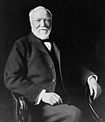
Branch Campuses Student life Traditions • Greek Life • Kiltie Band • Scotch'n'Soda • Miller Gallery • The Tartan • WRCT • University Athletic AssociationResearch Pittsburgh Supercomputing Center • Software Engineering Institute • Robotics Institute • Human Computer Interaction Institute • Language Technologies Institute • Pittsburgh Life Sciences Greenhouse • Carnegie SchoolPeople Projects and legacies Categories:- Association of American Universities
- Carnegie Mellon University
- Middle States Association of Colleges and Schools
- Educational institutions established in 1900
- Association of Independent Technological Universities
- Oak Ridge Associated Universities
- National Association of Independent Colleges and Universities members
- Pittsburgh History & Landmarks Foundation Historic Landmarks
- Universities and colleges in Pittsburgh, Pennsylvania
Wikimedia Foundation. 2010.

